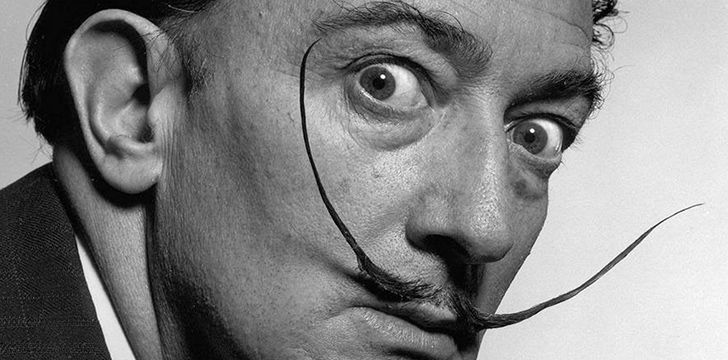10 surprising facts about Salvador Dalí

Salvador Dalí, a surrealist banished by his own people
When he arrived in Paris in 1926, Dalí revived the flame of the Surrealist movement. He is associated with Duchamp, Magritte, Man Ray and Brassaï. With the stylist Elsa Schiaparelli, he declines in fashion the offbeat use of usual objects: shoe-hat, lobster dress… But the shine and provocations of Catalan irritate the poet André Breton, godfather of the group. In 1934, Dalí said he was fascinated by Hitler (“a masochist who wants to lose the war”), and Breton took the opportunity to exclude him from the surrealist movement.
Salvador Dalí, an artist haunted by death
Dalí has the same name as his younger brother. He will often say that his eccentricities serve him to dominate this ghost. In his childhood, the sight of animal carrions fascinates and disgusts him at the same time. Soft flesh, ants will haunt his work. At 16, he lost his mother, the first support of his talent. The anguish of death never leaves him and pushes him to live intensely. On January 23, 1989, his disappearance revealed one last surprise to his relatives: he left everything to the Spanish state.
Salvador Dalí, a hard worker
During his stays in Paris (Hotel Meurice, Suite 102-103) and New York (Hotel Saint-Régis), Dalí is in a worldly mode. He receives and does his show. But when summer brings him back to his workshop in Port Lligat, Spain, he gets up at dawn and works until the night. In total confinement, he spends months on a canvas, produces dozens of lithographs, draws two hours a day on Ingres paper. The calm of the place allows it this concentration, and the phantasmagorical rocks of the coast constantly inspire it.
A movie with Disney
At the end of 1945, during his exile in the USA, Dalí dined with Walt Disney and together they designed the short film Destino. Left in the lurch due to lack of budget, the film will be taken over and completed in 2003 by Dominique Monfery, according to Dalí’s sketches. This six-minute narrative evokes the weight of time (embodied by the god Chronos) for two characters waiting for their destiny to come true. There are patterns dear to the master: soft watch, ants, crutches…
Salvador Dalí, a man of science
Dalí regrets that his colleagues are not interested in the scientific progress of their time, unlike a genius like Da Vinci. A faithful reader of Science and Life magazine, he delights in the discoveries of the atomic era, on antimatter, protons… “Matter is only energy. Everything we thought was material is being spiritualized.” His famous soft watches, which appeared in 1931 on the Persistence of Memory canvas, represent the flexible nature of time demonstrated by Einstein.
Salvador Dalí, both cheap and generous
When Dalí had to go into exile in the USA (between 1940 and 1948), Picasso paid him 500 dollars for the cruise ship trip. Despite his success, Dalí will be reluctant to repay his friend – a fact that contributes to the confusion in their relationship. Pious on a daily basis, incapable of charity, Avida Dollars (an anagram of his name, found by André Breton) said he was generous with the ideas and visions he spread.
Salvador Dalí, fetishist
Dalí carries with him his latest sketches and projects, in a small suitcase held at his wrist by a string. In a pocket, he keeps a piece of driftwood – a superstition he says is typically Spanish. Canes, crutches, ants, eggs, cauliflower and rhino horn are also part of his personal symbolism. His whiskers? Antennas as important as those of insects! Finally, at the table as in his painting, he likes the soft, the “super-gelatinous” ortolans and especially sea urchins (their digestion seems to favor especially inspiring dreams).
Lovers crazy about Gala
In 1929, Dalí fell madly in love with Paul Eluard’s young Russian wife. To seduce her, he invited them to his home in Port Lligat, a hundred kilometers south of Perpignan. It appears coated with cheese, feces, and blood from a cut. Impressed by her audacity, Gala will be her only female role model and will rule over her life. “With it, the scattered elements of my life became an architecture. She structured me in a clear way.” Married civilly in 1932, the couple waited for Eluard’s death to perform his real ceremony in 1958, at the Angels sanctuary near Gerona.
Salvador Dalí, fan of Jérôme Bosch
In painting, the artist hates Manet, Mondrian, Turner, Pollock, children’s drawings… He sees in abstract art only a barely decorative thing, but, above all, he hates Cézanne: “The worst painter in the world”, he eructates on French television. On the other hand, he loves Meissonier, Velázquez, Vermeer and Jérôme Bosch, whose Garden of Delights marks him.
Salvador Dalí has been running ads
“All great characters have a ridiculous side,” says Dalí. With jubilation, he takes advantage of the television to put himself on stage, intrigue, provoke, in the spirit of a permanent “happening”. He appears in ads for Lanvin chocolates, Nissan cars, Braniff and Iberia airlines… He draws the logo of the famous Chupa Chups lollipop in 1969 (which will be revised in 1988)! When asked by television host Jacques Chancel if the ad had daubed his work, he replied that he had daubed the ad.












